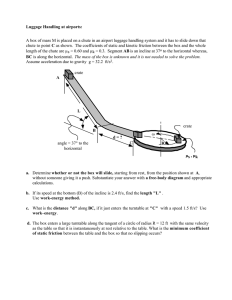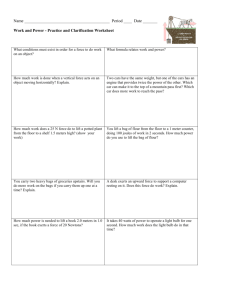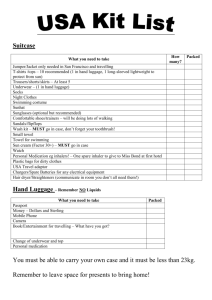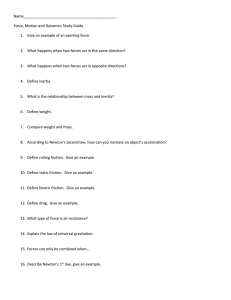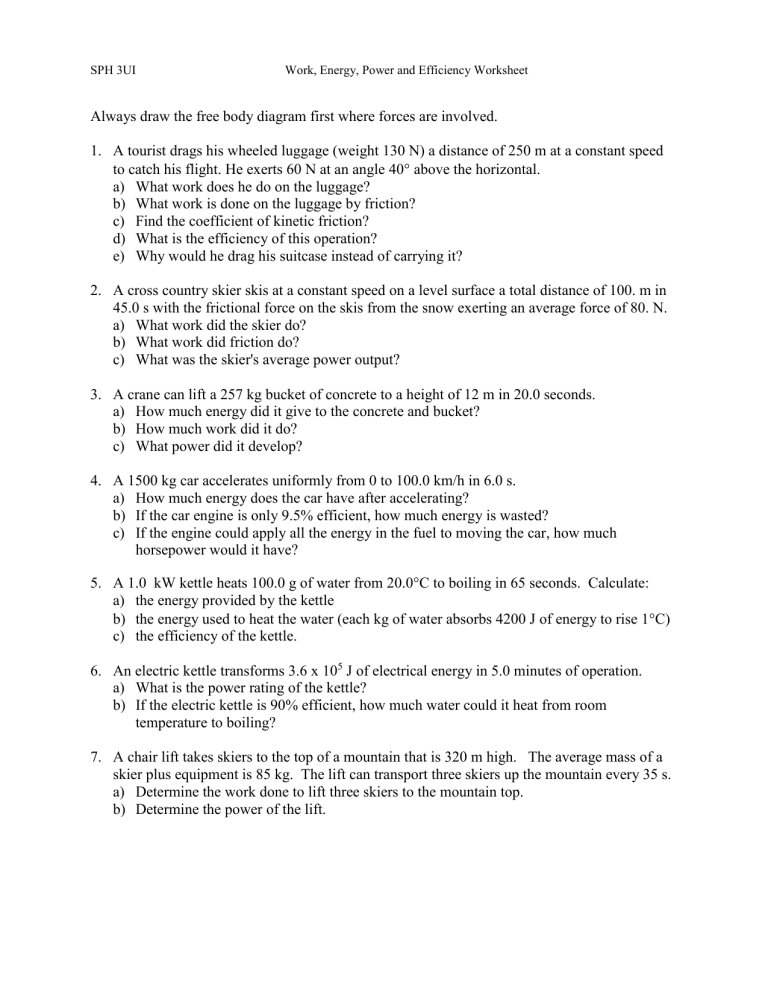
SPH 3UI Work, Energy, Power and Efficiency Worksheet Always draw the free body diagram first where forces are involved. 1. A tourist drags his wheeled luggage (weight 130 N) a distance of 250 m at a constant speed to catch his flight. He exerts 60 N at an angle 40 above the horizontal. a) What work does he do on the luggage? b) What work is done on the luggage by friction? c) Find the coefficient of kinetic friction? d) What is the efficiency of this operation? e) Why would he drag his suitcase instead of carrying it? 2. A cross country skier skis at a constant speed on a level surface a total distance of 100. m in 45.0 s with the frictional force on the skis from the snow exerting an average force of 80. N. a) What work did the skier do? b) What work did friction do? c) What was the skier's average power output? 3. A crane can lift a 257 kg bucket of concrete to a height of 12 m in 20.0 seconds. a) How much energy did it give to the concrete and bucket? b) How much work did it do? c) What power did it develop? 4. A 1500 kg car accelerates uniformly from 0 to 100.0 km/h in 6.0 s. a) How much energy does the car have after accelerating? b) If the car engine is only 9.5% efficient, how much energy is wasted? c) If the engine could apply all the energy in the fuel to moving the car, how much horsepower would it have? 5. A 1.0 kW kettle heats 100.0 g of water from 20.0C to boiling in 65 seconds. Calculate: a) the energy provided by the kettle b) the energy used to heat the water (each kg of water absorbs 4200 J of energy to rise 1C) c) the efficiency of the kettle. 6. An electric kettle transforms 3.6 x 105 J of electrical energy in 5.0 minutes of operation. a) What is the power rating of the kettle? b) If the electric kettle is 90% efficient, how much water could it heat from room temperature to boiling? 7. A chair lift takes skiers to the top of a mountain that is 320 m high. The average mass of a skier plus equipment is 85 kg. The lift can transport three skiers up the mountain every 35 s. a) Determine the work done to lift three skiers to the mountain top. b) Determine the power of the lift. SPH 3UI Work, Energy, Power and Efficiency Worksheet 8. A tennis racket exerts an average force of 225 N on a 0.20 kg tennis ball over a distance of 15 cm. a) How much work is done by the racket on the ball? b) What is the speed of the ball just after it leaves the racket (assume the ball was stationary to start)? 9. Workers exerts a constant force of 812 N to roll a 188 kg crate up a 5.6 m ramp sloped at 25. The crate moves at constant speed up the ramp. Calculate: a) The work done by the workers. b) The energy the crate has been given when it gets to the top of the ramp. c) Explain the difference between the answers in parts a) and b) above. 10. When 234.5 g of copper at 87.4°C is added to 154.5 g of water at 10.7°C, what will be the final temperature of the mixture? 11. a) How much heat energy would be released by cooling 250 g of water from 100°C to 20°C? b) If all the energy released in a) is used to heat copper shot from 6.0°C to 20°C, how much copper could be heated? 12. In an accident investigation, a 1.25 t car showed skid marks 6.70 m long on wet pavement (K= 0.900) How fast was the car moving? Answers: 1. a) 1.1 104 J 2. a) 8.0 103 J 3. a) 3.0 104 J 4. a) 5.8 105 J 5. a) 6.5 104 J b) -1.1 104 J b) -8.0 103 J b) 3.0 104 J b) 5.5 106 J b) 3.4 104 J 2 3 3 c) 0.50 c) 1.8 10 W c) 1.5 10 W c) 1.4 10 hp c) 52% d) 77% - although he exerts 60 N of force, only 60cos 40° N is doing scientific work, the rest (60sin40° N) reduces the load on the wheels. We are assuming that the wheels do not roll any easier when lifted slightly. e) Since a human arm cannot be locked in place, the muscles tire due to the drain of energy required to tense the muscle to carry the 130 N luggage. It is easier to exert a 60 N force than a 130 N force continually. If you could lock your arm to support the 130 N luggage or load it on a frictionless cart, moving the luggage horizontally would be effortless since there would no longer be friction with the floor and, once it was moving, no additional work would be done to keep it moving. 6. a) 1.2 kW b) 0.96 kg 7. a) 8.0 105 J b) 23 kW 8. a) 34 J b) 18 m/s 9. a) 4.5 103 J 10. 20.2°C b) 4.4 103 J c) energy is lost to friction 11. a) 8.4x104 J b) 15 kg 12. 10.9 m/s
